|
Southern Pacifiic's Santa Clara Yard and the last of the Train Masters ...before drones |
|
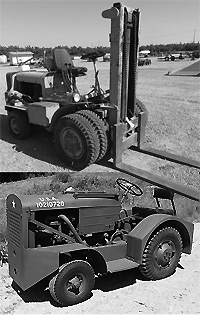 |
A happy proximity of work and railroad allowed me to shoot these photos in the winter of 1974 - 75, when Southern Pacific's last two Fairbanks-Morse Train Masters were running out their last miles on Peninsula Commute trains. I was doubly blessed with the availability of the era's technological equivalent of a drone: The Philift. Those of you familiar with World War II military equipment may notice the Philift's (image at left) resemblance to a tractor used to shuttle airplanes and bomb carriers around air bases, and you would be right. It once was a Case model VAIW "tug". In an inspired moment of utilitarian insight in the late 1950's, a fellow (named Phil? We don't know.) looked at the Case and saw its potential as an off road fork lift.
By 1974, I had already had a long and troubled relationship with the cranky, breakdown-prone Philift. Presently I was employed by Mayfair Packing Company to clean up demolition remains at the old Rosenberg cannery just north of Santa Clara Tower. Many decades before, the original South Pacific Coast narrow gauge main line ran through the middle of the site. Today, Santa Clara city offices occupies it. At the time, Mayfair also owned a walnut processing plant behind the depot, as well as the huge, abandoned Union Ice Company building to the depot's south. Mayfair had an equipment maintenance program identical to Southern Pacific's: defer it to death. Thus, during critical train moments, the tug's cooperation was far from assured. Thus many of the photos below were taken under more Zen-like conditions on the ground. When the Philift did run, I could rush out to the tracks, climb onto the hoisted forks and photograph away. Today, a few twiddles of the your thumb on a drone's joystick and shutter button will accomplish the same thing, but what feeling of physical accomplishment is there in that, I ask you? Regarding the photos themselves, I am not sure of the date of any given image. Most of then date to November-December, 1974, but I took a few of them in late January, just before sole remaining Train Master #3031's last run on February 5, 1975. No. 3021 failed forever at Santa Clara on December 26. Train #147 was nearly a sure thing to have an H24-66 until #3021 gave up the ghost. The photo quality leaves something to be desired since the film was lost for five years before it was developed. At least I found it... I had no idea at the time that in three years the table would be turned. I would watch subsequent developments at Rosenberg from my railroad workplace. |
|
|
|
| First, a truly in situ view... I am standing at about the loation of the original South Pacific Coast main track through Santa Clara. Former Rosenberg warehouse are on the left and right, while the tower is off the view at right. No. 3031 is headed west on train #147. | 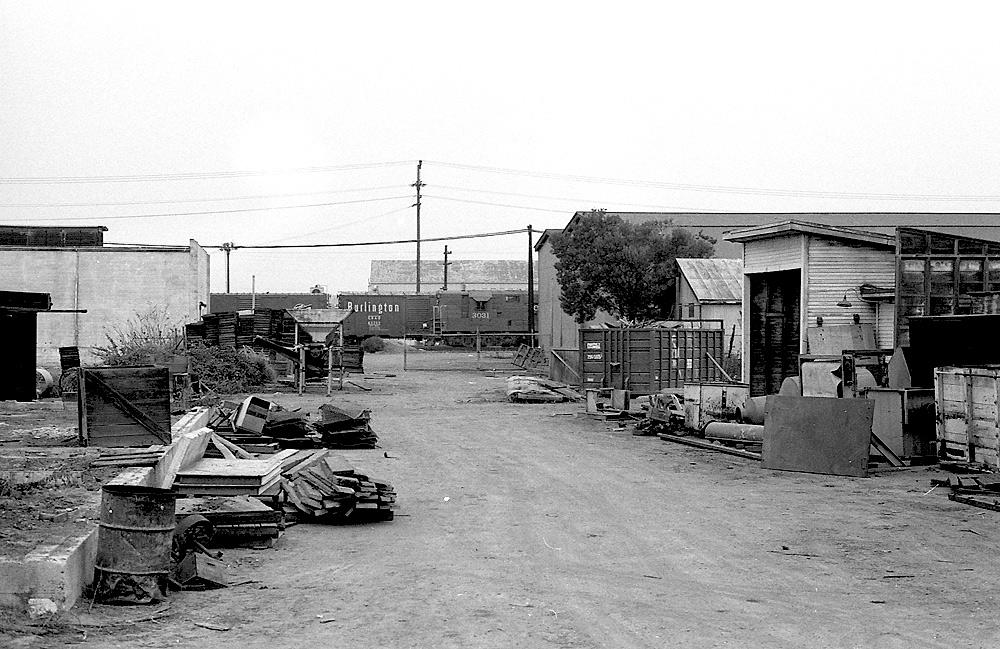 |
|
|
|
| This sequence, featuring #3021 at the head of train #147, dates to November, 1974. Unfortunately, I was unable to capture the fireman's facial expression when he noticed me on the Philift. No. 3021 failed at Santa Clara on December 26 (and was subsequently vacated), it being the holidays, I was not around for the show. That is the Mulford Line branching out from the Westbound down near the overpass in the bottom photo. Next to it are the Long and Short Sidings that served as switching leads. |
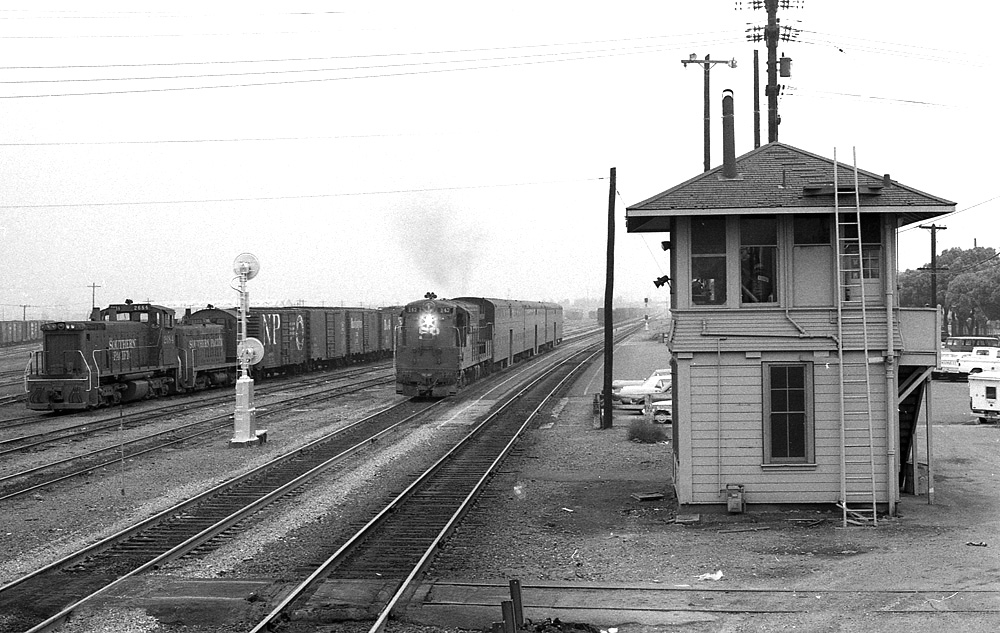 |
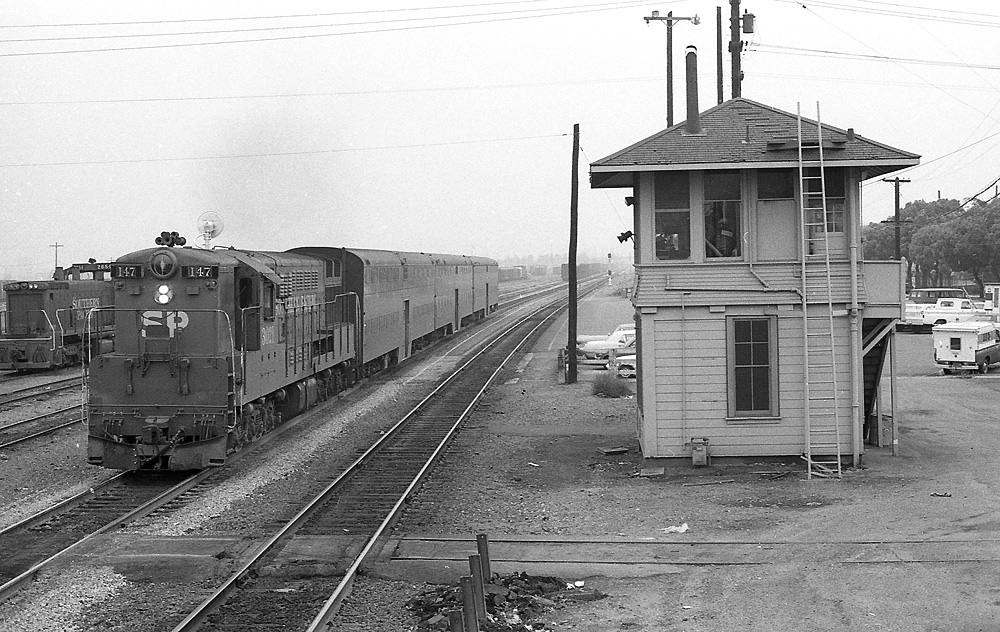 |
|
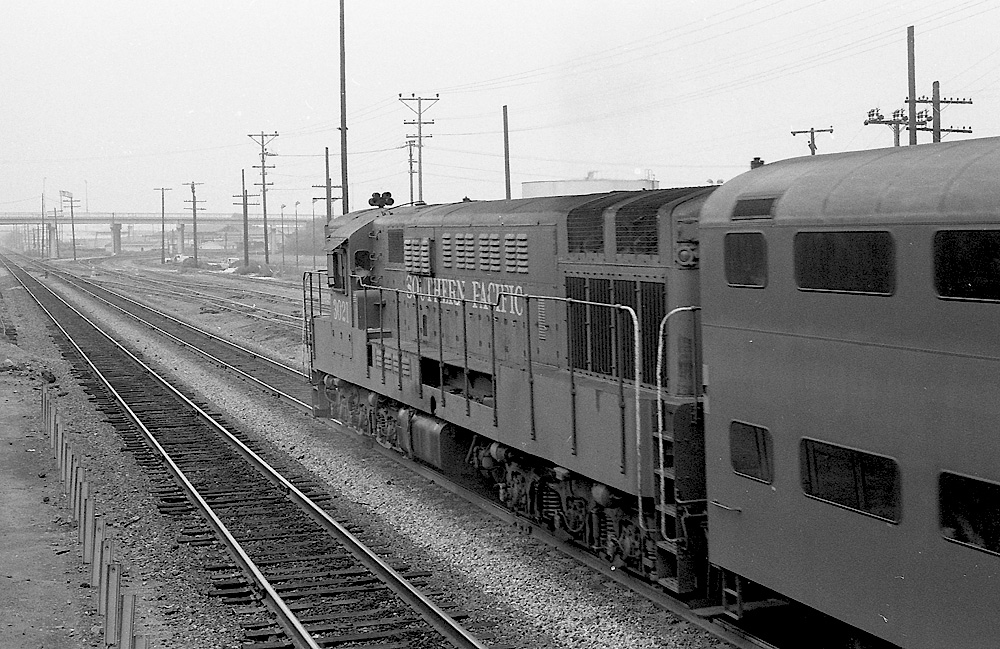 |
|
|
|
|
| On another day in November we see the final member of the last man standing club, #3031, also on train #147. Although it is only 3:00 pm, the shadows are already growing long. The depot was painted a light green back then, and Acme Freight forwarders occupied the depot freight room, which later became the headquarters of the Central Coast Railway Club. Bottom: While I was waiting for #147, a presumed Pool Four (Watsonville - Oakland) job was busy doubling over on #33 track in the yard. SD39's like lead unit #5307 were not heavy frequenters of the Coast, but SD45T2's like trailing SSW #9160 were "commons". There also is a light engine movement near the tower, perhaps the power for a waiting Pool 1 (Oakland - Tracy - San Jose) train in the yard. |
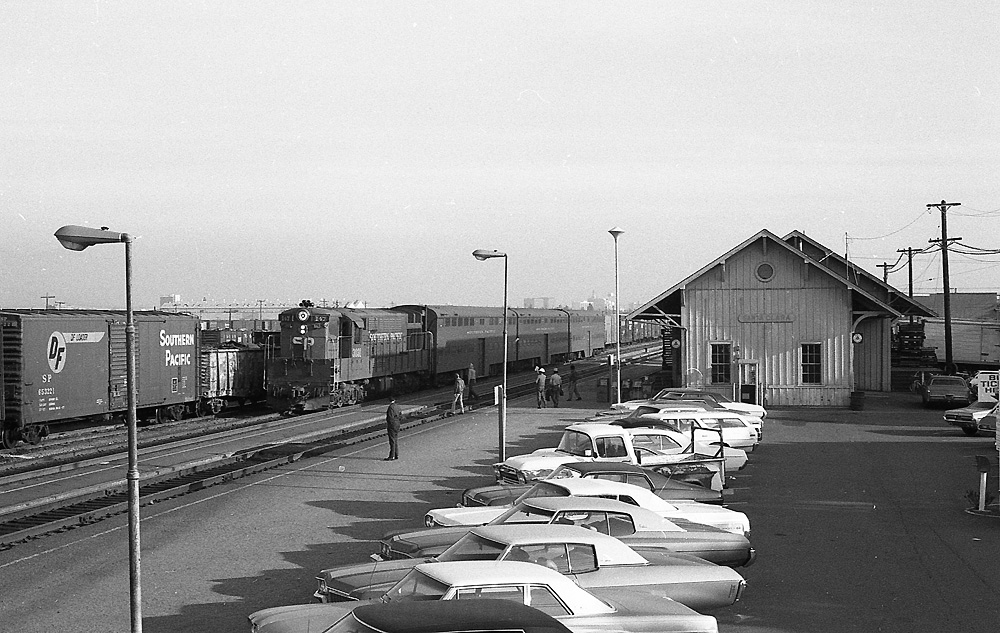 |
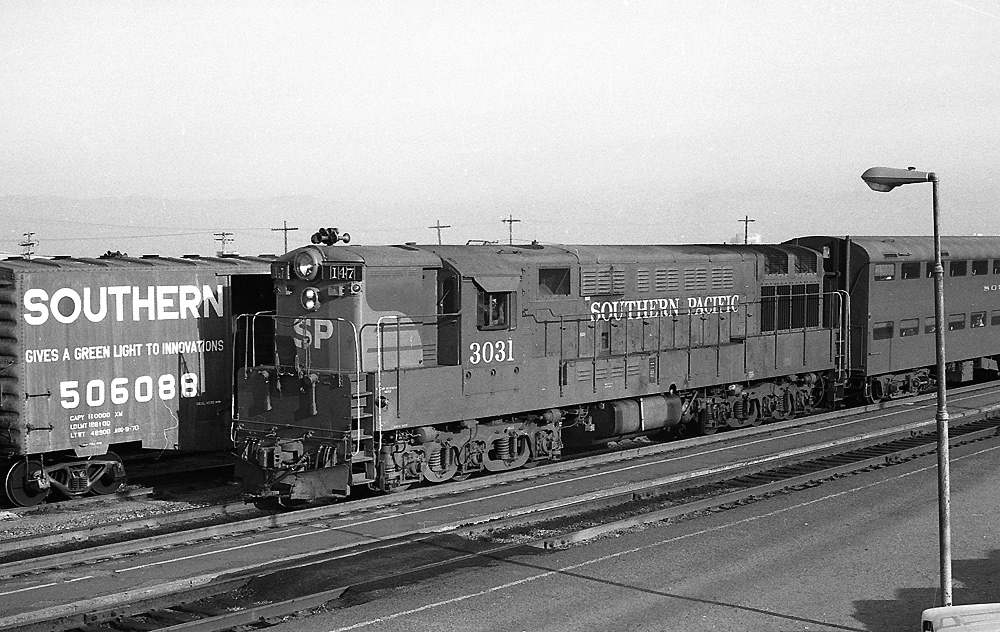 |
|
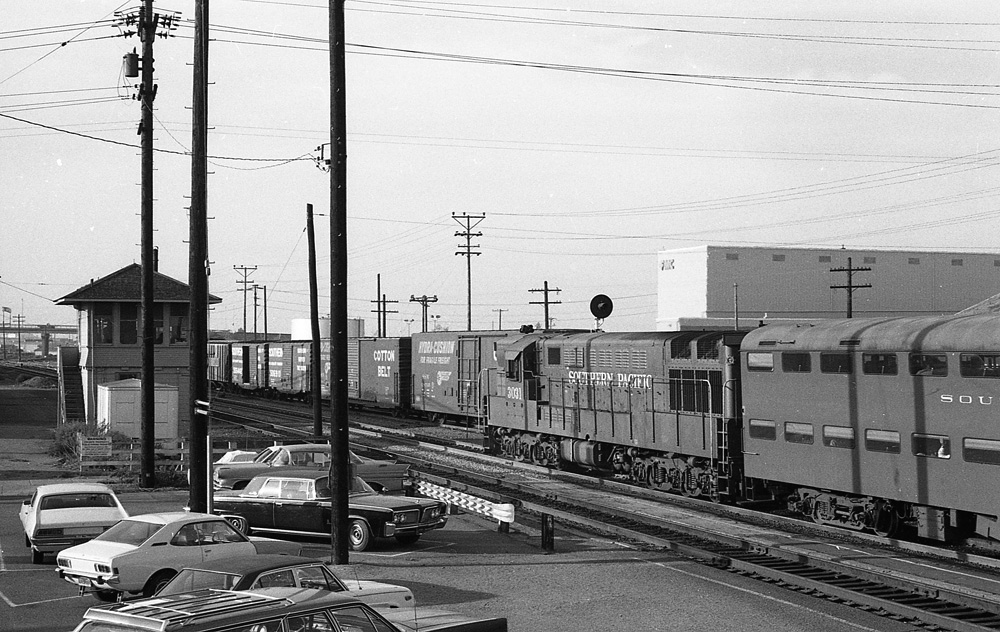 |
|
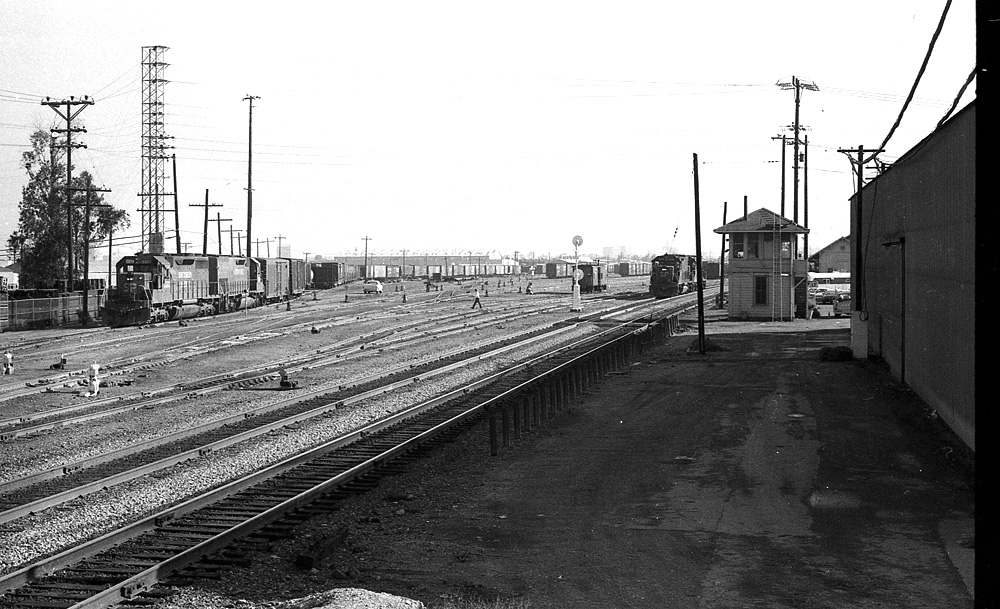 |
|
|
|
|
And of course there were Geeps and Amtrak FP45's: At top we see #3004 on what is suspected to be #147, but apparently mislabeled as #141 by the fireman, who was responsible for hanging train numbers. The real #141 departure time at Santa Clara was 10:10 am, when the sunlight would be from the east, instead of the west, as here. Just barely discernible at far right in the photo is a semi truck backed up to the Acme Freight platform, and in front of it, a 25 cents per day parking sign. Next we see train #118 arriving, if everyone was on time, just six minutes before #147. The engineer on this one definitely had his bemused eyes fixed on me and my apparatus. 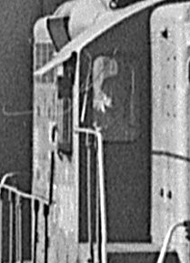 This shot shows something else worth pointing out: those undulating, tumbleweed covered rails in the old switch lead tail track at the far left. As you can see, it was connected to an interlocked crossover. Long before this photo, SP began employing the track just beyond the crossover as a parking spot for a standby engine during morning "Fleet" hours. In those days, when a loco conked out, the crews and towermen took care of the matter, with no "mommy may I?" calls to the train dispatcher. Though this was train order territory, it was double track (a.k.a. D-251 territory), where movements required a Clearance, but no running orders to occupy main track to run with the current of traffic. Thus, when an engine failed, its crew would radio would radio "mayday" to the standby engine, which in turn would talk to the towerman, who would line the loco through the crossovers to the westbound main ASAP. Depending upon the circumstances, it could get complicated during the actual rescue, but usually not to the point where the dispatcher was directly involved. During early Caltrain years, the SCO's (dispatchers) continued allowing crews to do this job, as always. This grated upon Amtrak's management, which progressively made the SCO's the decision makers. This finally became so uneccesarily overbearing that one day, after two very old head crews took care of a breakdown by hitching trains together at 22nd Street, the somewhat elderly rescue engineer called the SCO with, "Is it OK for us to proceed to San Francisco?" I doubt that the SCO got the real message. Southern Pacific train #12, a.k.a. Amtrak train #11's lead SDP40 #569 (#532 trailing) was only about six months old at the time, but nevertheless was retired in 1977, and its components used to construct F40 #242. |
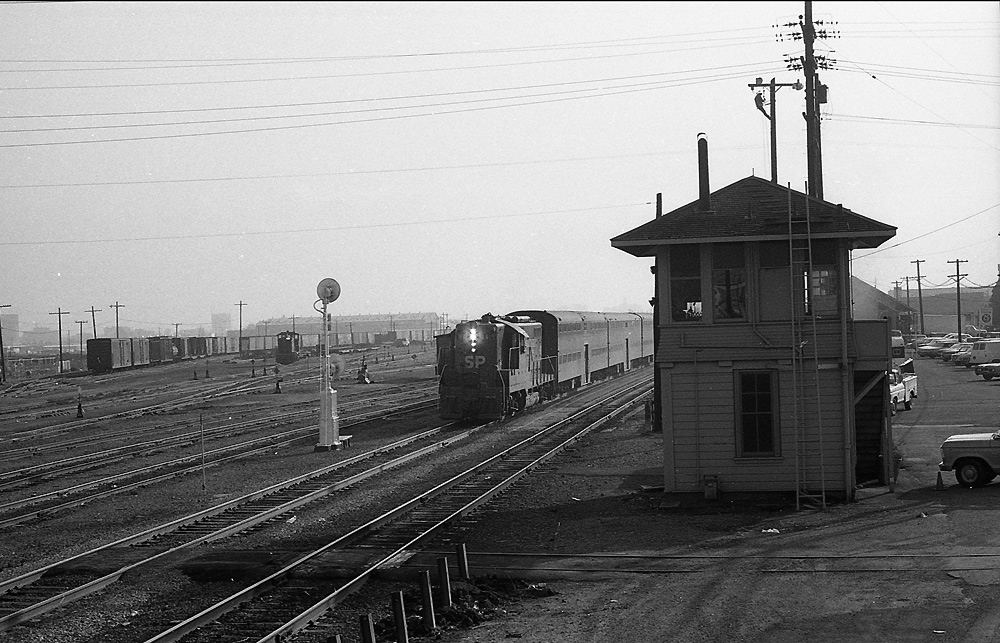 |
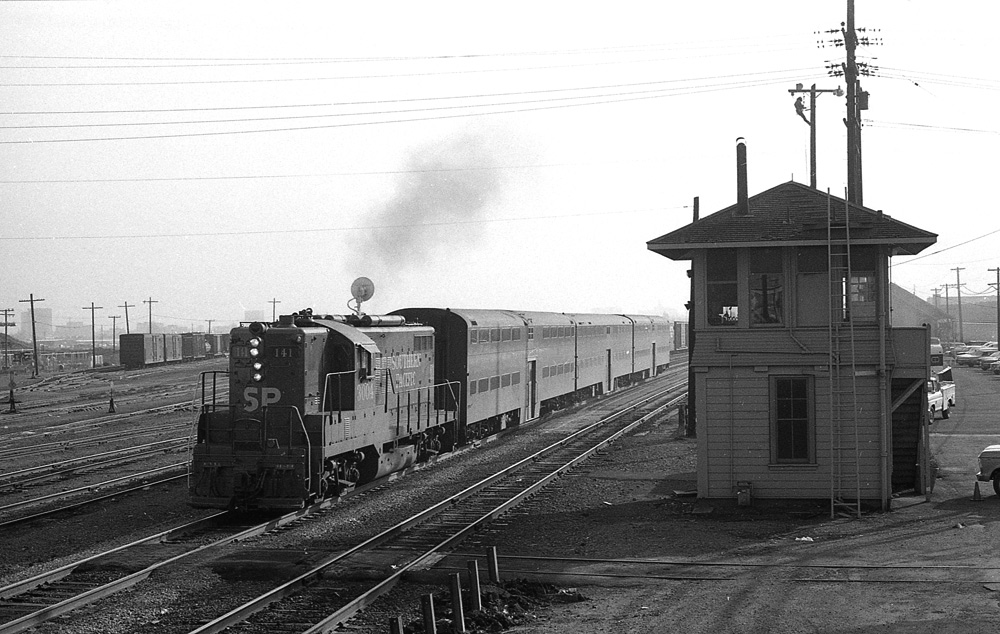 |
|
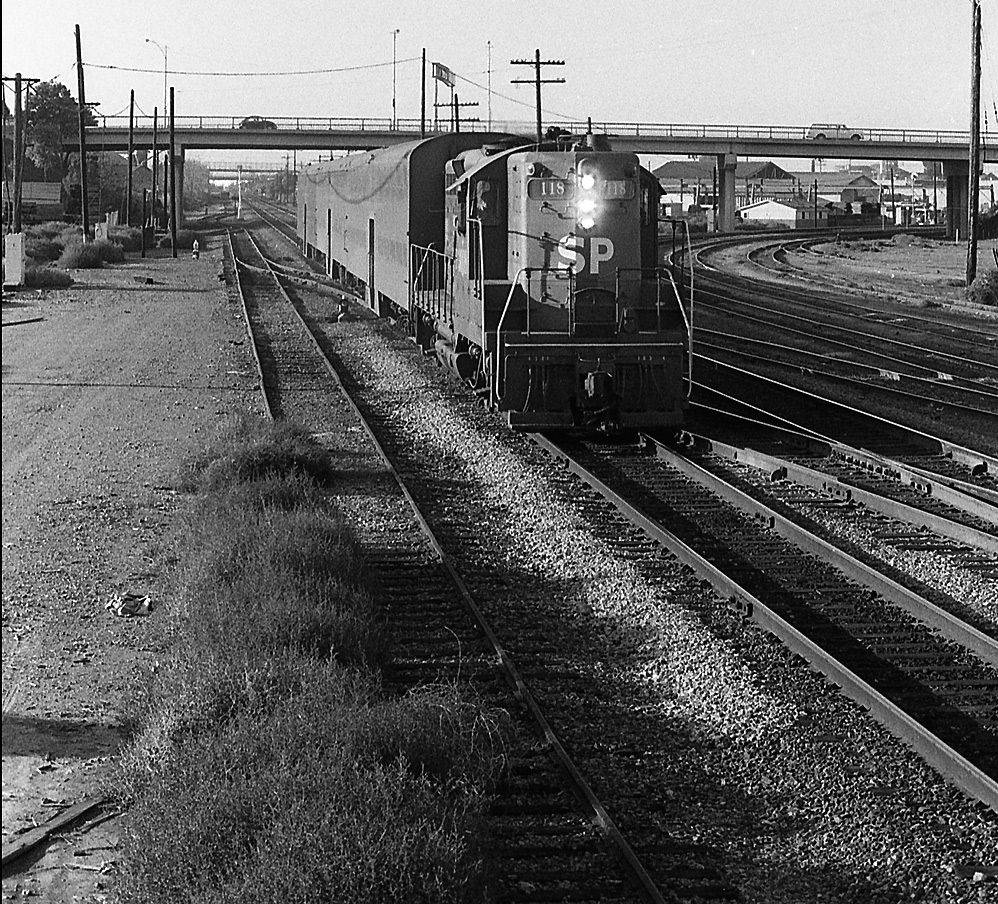 |
|
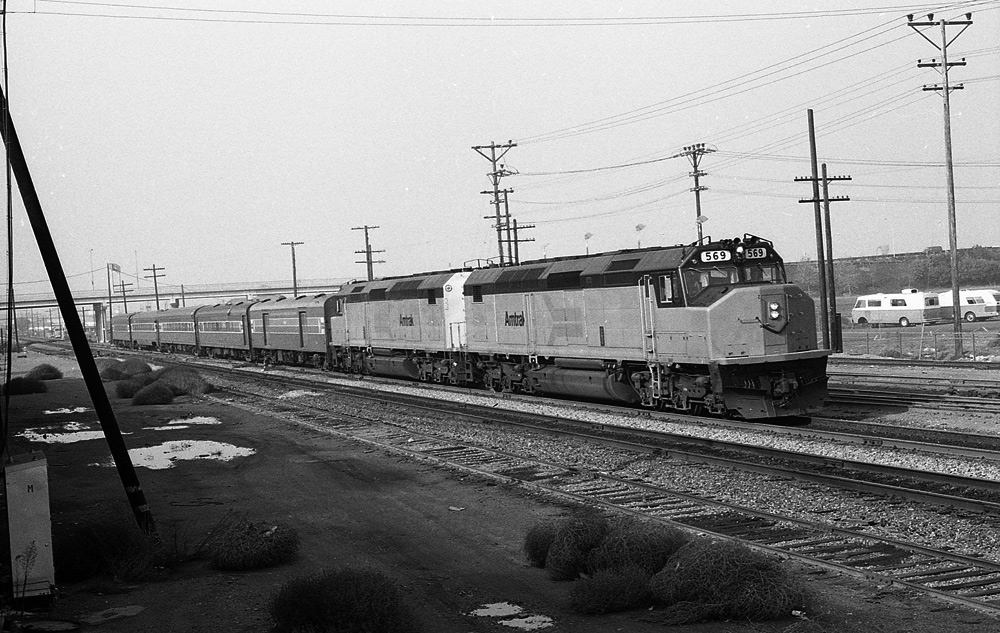 |
|
|
|
|
|
a more grounded perspective
|
|
| A confession to Operation Lifesaver: Train #133 was another "regular" for the TM's until #3021 quit for good. This is my only photo of #133, because it called on Santa Clara at 7:21 am, on average a half hour before I completed my morning ritual of bringing the recalcitrant Philift to life. Only then, when I was assured that I needn't call the company mechanic, did I turn to more enjoyable pursuits. This day, for some reason the Philift must have immediately fired up, because here I am at the tracks. I would point out the wisdom of not parking the Philift on the tracks for the shot. I also wish to point out that my wisdom did not extend towards awareness that #110 was about to part the fog behind me. I barely had time enough to get off the tracks and onto the forklift before #110 dived into the station. No. 110 never had a TM on the head end at the time, so it normally was not a subject of interest. |
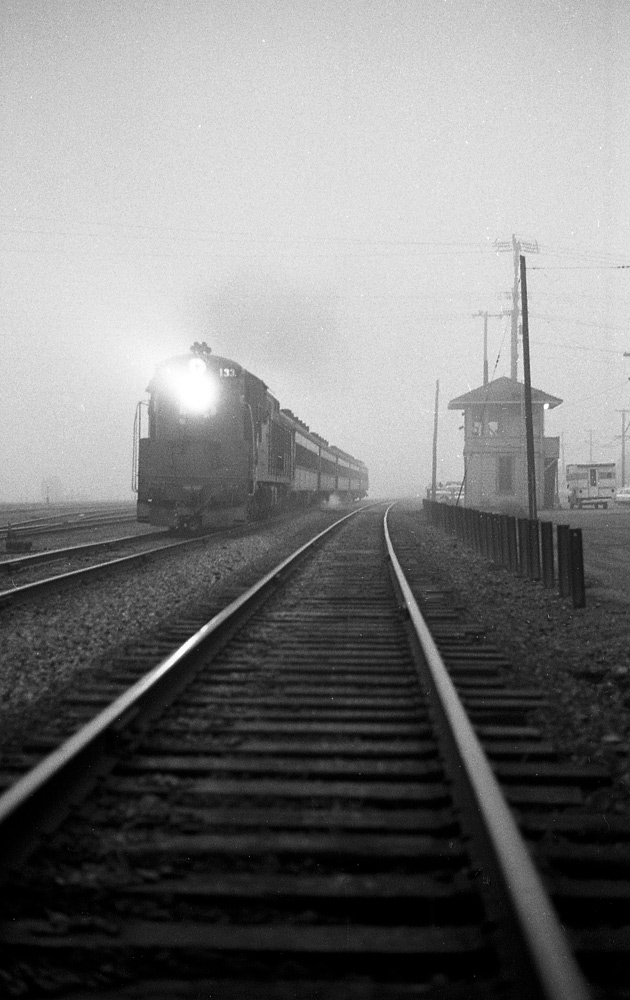 |
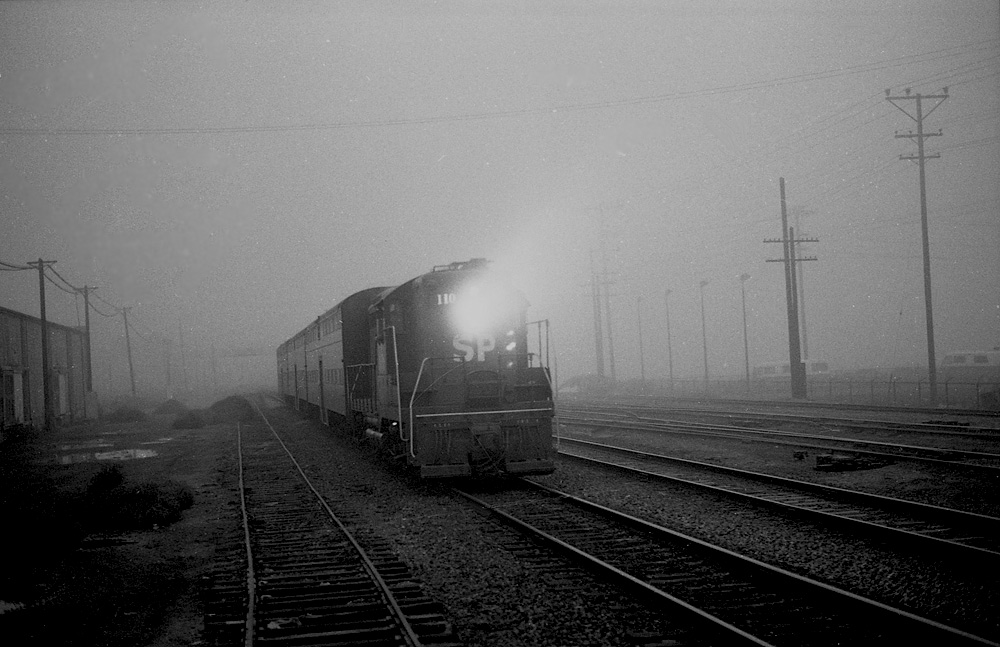 |
|
|
|
|
| Farewell, Train Masters: This late January, 1975 shot of #3031 was my last of any sort of an SP Fairbanks - Morse. I scanned its negative 20 years ago, with an inferior scanner, and promptly misfiled it. | 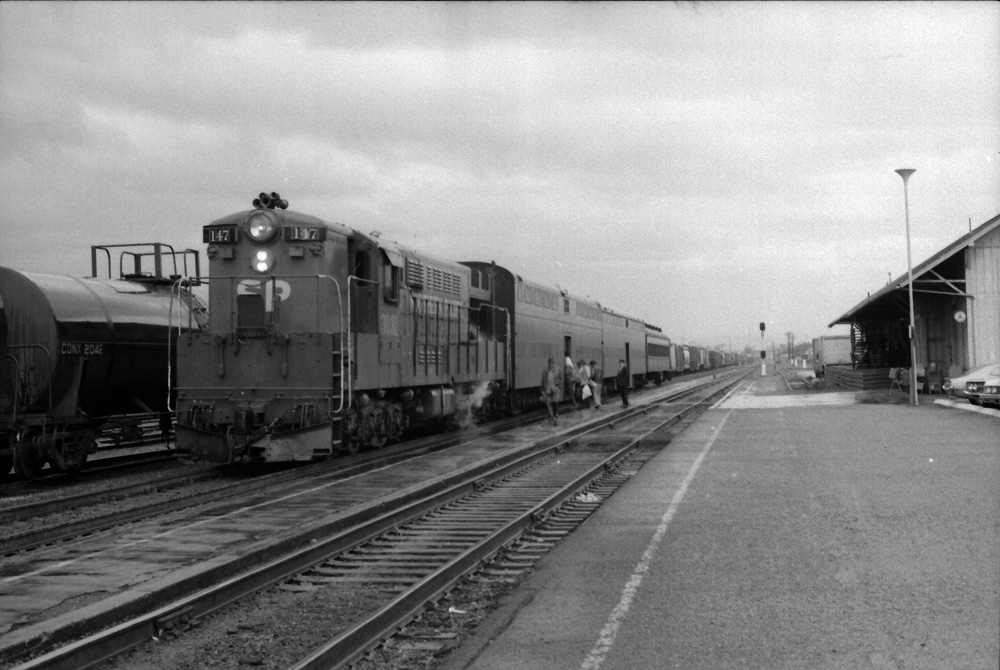 |
|
|
|
| Without knowing the details, one might identify this photo as taken during a summer smog attack, what with the number of locos and boxcars about, but nope, it is November. Note the boxcar spotted at the depot and an eastbound plug waay doen by Newhall Tower. Identifiable locos: #9279 and #9058 at center; and #9240 by itself (maybe a Pool 1 job, or the Newark Turn). The three on the left all appear to be SD45's. | 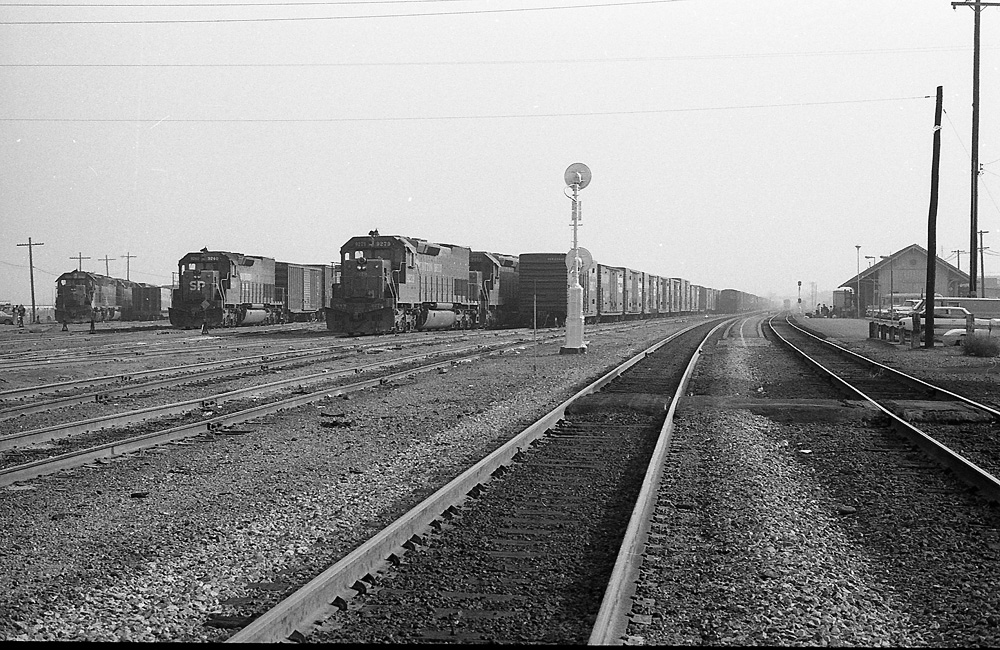 |
|
|
|
| Why include this mundane roster shot? Primarily, the reason is that it is the only halfway decent shot that I ever took of the beast, the first loco that I ever rode for pay as a new hire switchman. During my student training one morning we newbies were sent via Carryall to College Park Yard, where #1193 stood ready accompanied by a crew of elderly switchmen with pockets full of torpedoes to enhance our learning experience. After practicing mounting and dismounting moving boxcars amid strings of exploding torpedoes for an hour - as long as any switchman could be expected to work at one stretch - - Engineer Chestnut called College Park Tower to see if anything was out on "The Western" (Milpitas Line). Assured that there was not any opposing activity, we 10 trainees, plus crew, plus instructor Jackie Bigelow all climbed aboard the loco for a short ride out to Eighth and Taylor Street, which local rails errantly called "Chinatown", even though it was properly "Japan Town". There we were introduced to "Beanies" a tremendously popular hash house. I can't recall its real name, but it was pretty famous by the time it close around the turn of the century. Then back to College Park, where #1193 was exchanged for #1191 because the former was out of gas. Then we practiced tying air hoses and mounting boxcars while holding a lantern (handheld radios were still in the future). Engineers of robust dimensions were not fond of the likes of #1193, because the were equipped with #5 brake valve, which stuck out from the control stand enough to painfully limit said portly engineer's ability to swivel on his seat. These guys really missed the H12-44's that these EMD's replaced. |
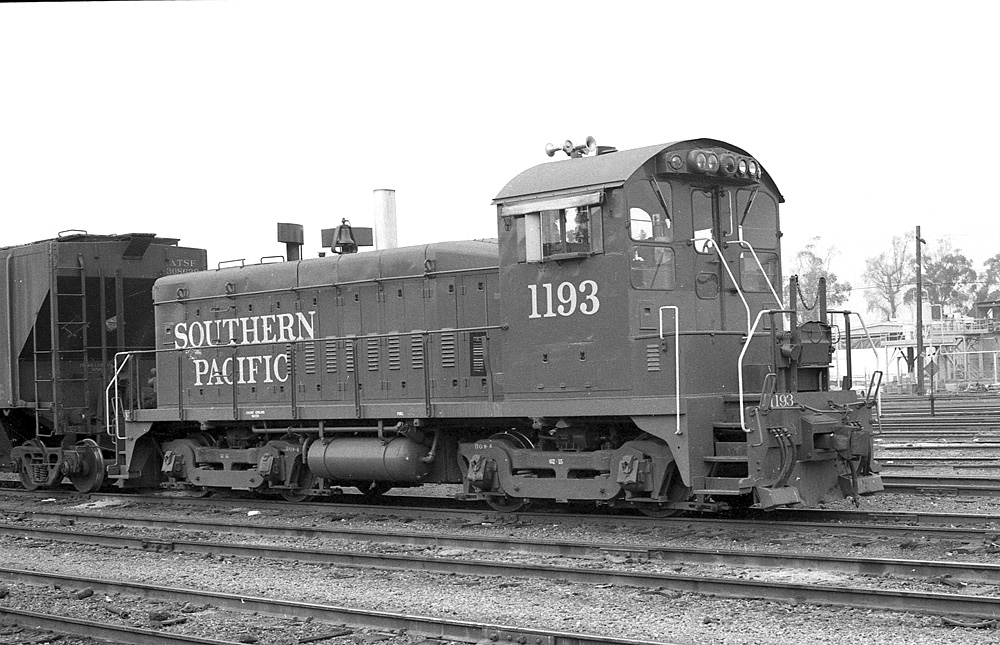 |
|
|
|
| Waiting on the train: As this was train #143, I was not expecting a Train Master, but likely because the Philift was comatose, I headed over to the depot this November afternoon anyway. Surely enough, #3006 was on the head end. But look at the antiquities that I might have otherwise missed: the haircuts, the bellbottoms the still in use freight platform, the mailbox, the public telephone inside the waiting room, all of those newspaper stands, and certainly the train itself. |
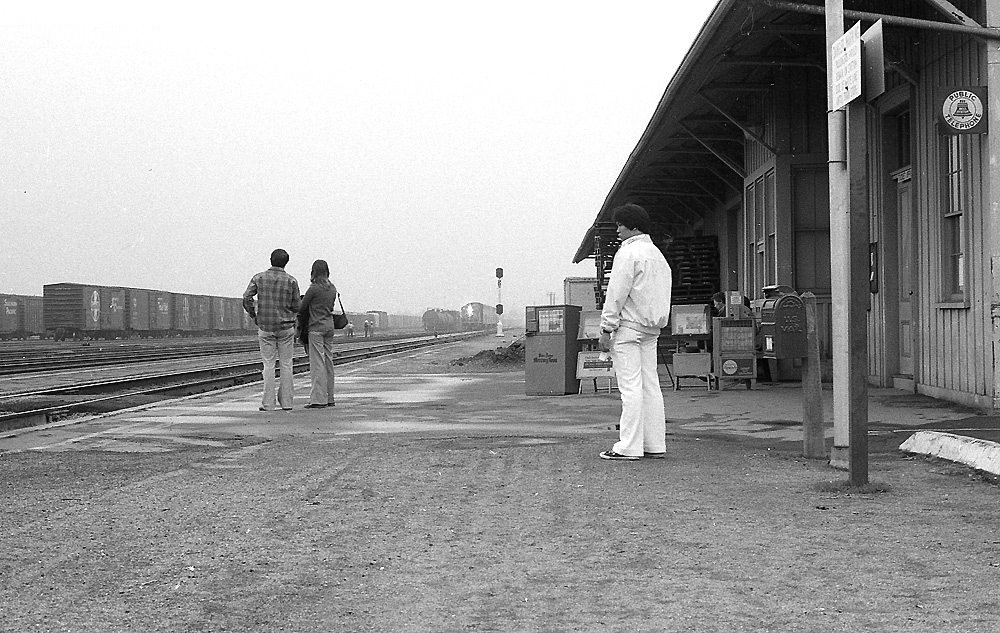 |
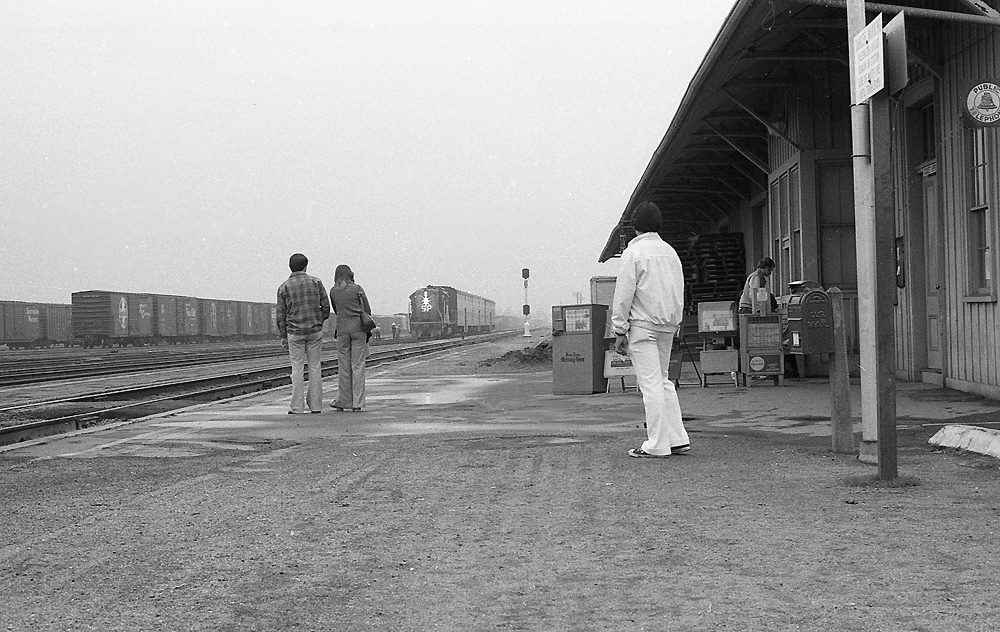 |
|
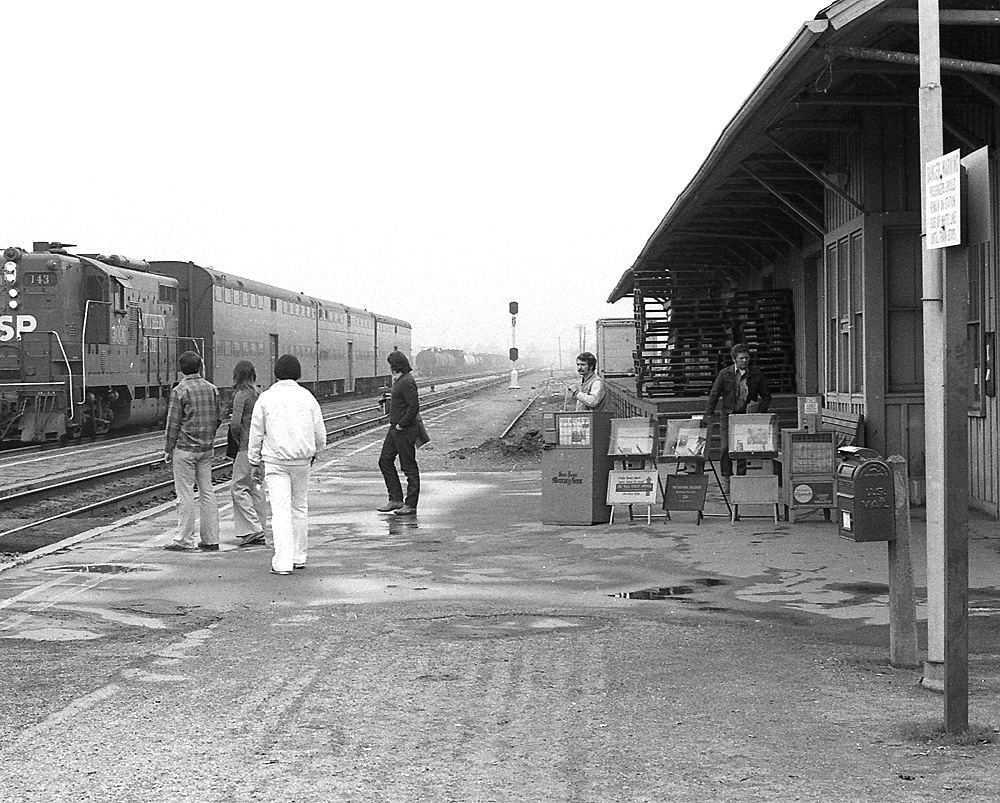 |
|
|
|
|
|
the end
|
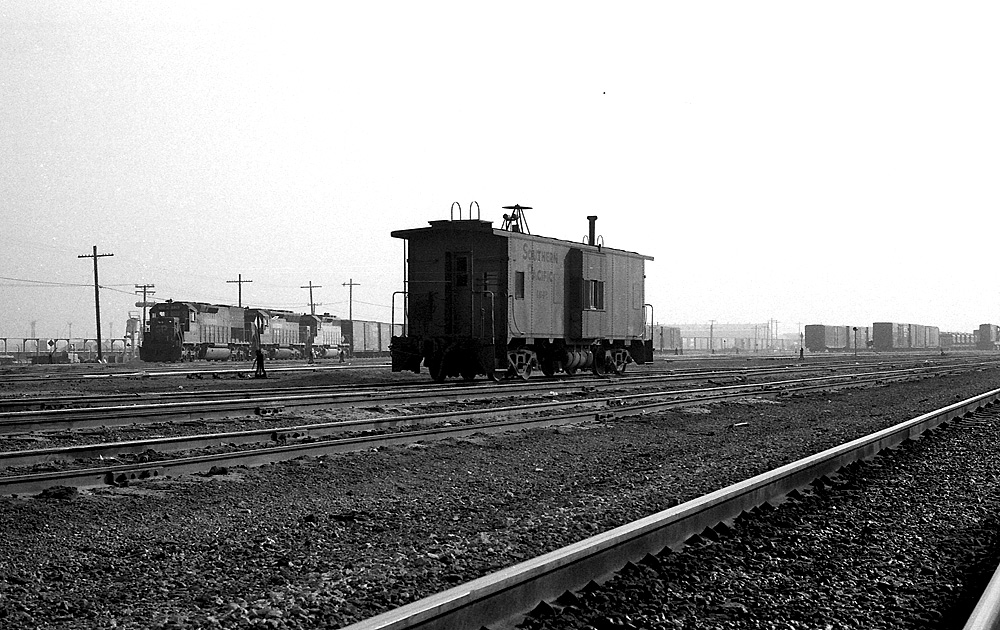 |
